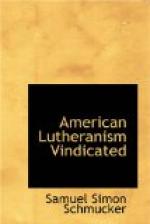Smalcald, Article VI.
“Concerning the Sacrament of the Altar, we hold that the bread and wine in the Eucharist, are the true body and blood of Christ, which are administered and received, not only by pious, but also by impious Christians.”—Symb. Books, p. 384.
Luther’s Smaller Catechism.
“What is the Sacrament of the altar?
“Ans.—It is the true body and blood of our Lord Jesus Christ, with bread and wine, instituted by Christ himself, for us Christians to eat and drink.”—Symb. Books, p. 124.
Form of Concord, Pt. I., Art. VII.
“We teach that the true body and blood of our Lord Jesus Christ, are truly and essentially, or substantially, present in the Lord’s Supper, administered with the bread and wine, and received with the lips by all those who use this sacrament, be they worthy or unworthy, good or evil, believing or unbelieving; being received by the believing unto consolation and life, but by the unbelieving unto judgment."-Symb. Books, p. 570.
“We believe, teach, and confess, that the words of the testament of Christ, are not to be understood otherwise than according to their literal sense, so that the bread does not signify the absent body of Christ, and the wine the absent blood of Christ, but on account of their sacramental union, that the bread and wine ARE truly the body and blood of Christ.” (Sondern dass es wahrhaftig um sacramentlicher Einigkeit willen der Leib und Blut Christi sei. Sed ut propter sacramentalem unionem panis et vinum vere sint corpus et sanguis Christi.)—Idem., p. 571.
“We believe, teach, and confess, that not only the truly believing and the worthy, but also the unworthy and the unbelieving, receive the true body and blood of Christ."-Page 572.
“In addition to the above clear passages, incontestably teaching the real presence, it deserves to be ever remembered, that only fourteen years after the Form of Concord was published, when Duke Frederick William, during the minority of Christian II., published the VISITATION ARTICLES OF SAXONY, in 1594, in order to suppress the Melancthonian tendencies to reject this and other peculiarities of the symbols, the Article on this subject which was framed by men confessedly adhering to the old symbols, and designing to re-enunciate their true import, and which was enforced upon the whole church in Saxony as symbolic, gives the most objectionable view of this doctrine, viz.: I. ’The pure doctrine of our church is, that the words, ’Take and eat, this is my body: drink, this is my blood, are to be understood simply and according to the letter.’ II. That the body (which is received and eaten,) is the proper and natural body (der rechte natuerliche Leib) of Christ, which hung upon the cross; and the blood (which is drunk) is the proper




